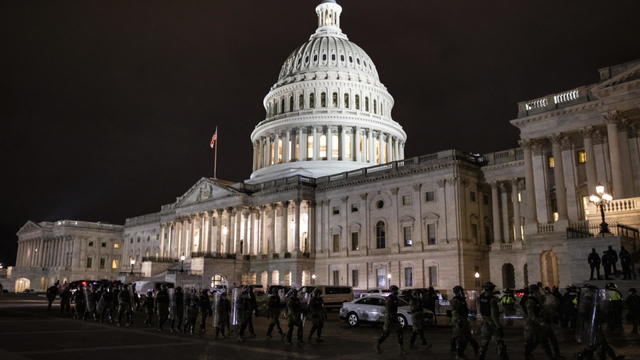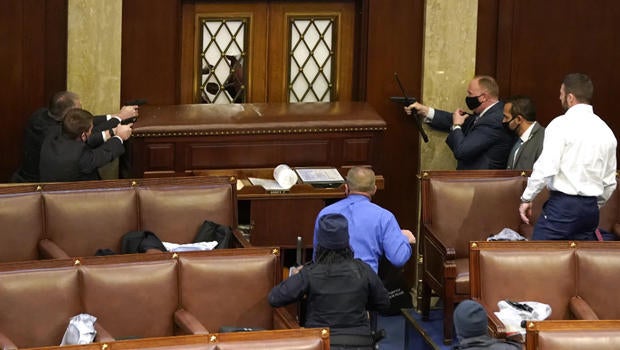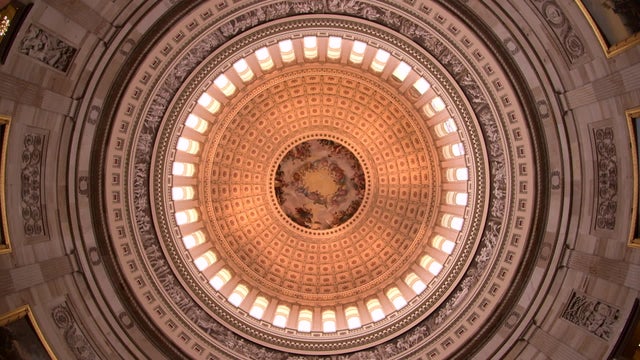The history of the U.S. Capitol
After the mob had been removed, this is what the Capitol looked like — as if it were glowing from within, instantly recognizable, shining on a hill.
"I consider it the most beautiful building in America," CBS News chief Washington correspondent Major Garrett reported on Wednesday evening, hours after the attack. "The Capitol is lit up, not just to aid law enforcement in the removal of these insurrectionists, but also to look the way it does, to be a shining light, but also to be symbol to the country. It will endure."
It is a building Americans take personally, regard with wonder and awe, which is why the nation watched in shock as some terrible line was crossed on Wednesday, with that picture of police protecting lawmakers, pointing their guns at the door every president since Woodrow Wilson has entered to deliver the State of the Union address.
It is a building weighted with the accumulated history of our country.
"The U.S. Capitol is amongst the most architecturally-significant buildings in the entire world. In fact, it is the symbol of Western democracy," said Brett Blanton, the 12th Architect of the Capitol, responsible for preserving and maintaining it.
Correspondent Martha Teichner asked, "When the founding fathers were looking to build a Capitol, what did they want to achieve with the structure?"
"They were looking for something that is to represent our form of democracy," Blanton replied.
George Washington wrote that it "ought to be upon a scale far superior to anything in this country."
Washington presided as the cornerstone was laid (according to newspaper accounts at the southeast corner of the building) on September 18, 1793. Congress began meeting there in 1800. Built by indentured servants and enslaved people, it wouldn't be finished until 1826 — in part because the British burned it in August of 1814, during the War of 1812.
- The 1814 burning of Washington, D.C. ("Sunday Morning," 8/31/14)
"We had burned the Parliament House of Canada and the Governor's House of Canada, so they were just basically coming back and returning the favor, if you will," said Bill Allen, historian emeritus for the Architect of the Capitol.
He said, "The Senate is a stage. The House is a stage. The outside of the Capitol is a stage. The whole building is a stage, and upon these various stages, the drama of our country is played out. Some of it's petty, some of it's noble, some of it's funny, some of it's sad."
By the 1850s, the building had to be expanded. When Abraham Lincoln was inaugurated in 1861, the new dome was still under construction. In spite of criticism, Lincoln kept building during the Civil War, saying, "If people see the Capitol going on, it is a sign we intend the Union shall go on."
The backdrop for Inaugurations since Andrew Jackson's in 1829, the Capitol has been under construction or re-construction almost constantly.
Teichenr asked, "Have you encountered any surprises?"
"One big surprise is we can't find the original cornerstone," Blanton replied.
Nearly one-million square feet, 600-plus rooms, miles of corridors, art everywhere, the Capitol is meant to impress.
Blanton's favorite place in the building is Statuary Hall. "It's its own museum of history, because you have statues, two per state are commissioned, and you get to see throughout history who the states feel represented them. Plus, in there, that's the location of the original House, and on the floor are placards of where the famous House members, such as Abraham Lincoln, where their desks were."
It was in Statuary Hall that Supreme Court Justice Ruth Bader Ginsburg lay in state last September, on the catafalque constructed for Lincoln's casket. Lincoln himself lay in the Rotunda.
Only 38 Americans have been granted what is seen as the nation's highest honor in death. Among them: former presidents, unknown soldiers, eminent Members of Congress, religious and civil rights leaders. The two Capitol policemen killed here in 1998 by a crazed gunman.
So, hallowed ground defiled on Wednesday ... but not for the first time. "The Capitol has always been a magnet for people wishing to air grievances," said Allen.
In 1835, somebody tried to assassinate President Andrew Jackson as he left the building.
In 1856, a pro-slavery Congressman from South Carolina just about killed Massachusetts Senator Charles Sumner, an abolitionist, as he sat in the Senate chamber.
In 1954, Puerto Rican nationalists shot up the House of Representatives, wounding five.
There have been bombings (as in 1983), and of course, on 9/11, the fourth plane — the one passengers forced down in Shanksville, Pennsylvania — was headed for the Capitol.
Before COVID, before Wednesday's attack, an estimated 3 to 5 million people visited the Capitol each year. A fence went up around it on Thursday, for the time being shutting the doors of the people's house to the people. But only for the time being.
"If you think about it, the Capitol is a very resilient structure," said Blanton. "It's been built; it's been burnt; it's been rebuilt; it's been expanded; it's been restored, and all of that as the monument for the American people and our form of government. It has stood the test of time."
For more info:
- U.S. Capitol
- Architect of the Capitol
- "History of the U.S. Capitol: A Chronicle of Design, Construction, and Politics" by William C. Allen (Trade Paperback)
Story produced by Jon Carras. Editor: Carol Ross.
See also:
- Almanac: The U.S. Capitol building opens ("Sunday Morning," 11/17/19)
- Almanac: Statuary Hall ("Sunday Morning," 7/2/17)
- The Capitol: A work in progress (CBS News, 2/04/02)
- Haunted house on the hill (CBS News, 10/31/03)


